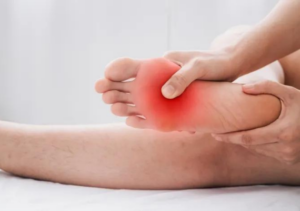Forefoot pain refers to discomfort or pain located in the front part of the foot, specifically involving the metatarsal bones, toes, and surrounding soft tissues. It can arise from various causes and affect daily activities and mobility.
Causes of Forefoot Pain
- Metatarsalgia: Pain and inflammation in the ball of the foot, often due to excessive pressure or overuse.
- Morton’s Neuroma: Thickening of tissue around a nerve leading to the toes, causing pain and discomfort.
- Bunions: Deformity of the big toe joint, leading to pain and pressure on the forefoot.
- Toe Deformities: Conditions like hammer toes or claw toes can cause discomfort in the forefoot.
- Metatarsal Stress Fractures: Small cracks or breaks in the bones of the forefoot due to repetitive stress or overuse.
- Capsulitis: Inflammation of the ligaments surrounding the joints in the forefoot.
- Arthritis: Osteoarthritis or rheumatoid arthritis affecting the joints of the forefoot.

